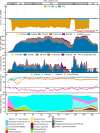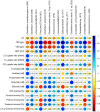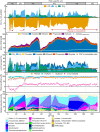Two-stage conversion of syngas and pyrolysis aqueous condensate into L-malate
- PMID: 38907325
- PMCID: PMC11191387
- DOI: 10.1186/s13068-024-02532-2
Two-stage conversion of syngas and pyrolysis aqueous condensate into L-malate
Abstract
Hybrid thermochemical-biological processes have the potential to enhance the carbon and energy recovery from organic waste. This work aimed to assess the carbon and energy recovery potential of multifunctional processes to simultaneously sequestrate syngas and detoxify pyrolysis aqueous condensate (PAC) for short-chain carboxylates production. To evaluate relevant process parameters for mixed culture co-fermentation of syngas and PAC, two identical reactors were run under mesophilic (37 °C) and thermophilic (55 °C) conditions at increasing PAC loading rates. Both the mesophilic and the thermophilic process recovered at least 50% of the energy in syngas and PAC into short-chain carboxylates. During the mesophilic syngas and PAC co-fermentation, methanogenesis was completely inhibited while acetate, ethanol and butyrate were the primary metabolites. Over 90% of the amplicon sequencing variants based on 16S rRNA were assigned to Clostridium sensu stricto 12. During the thermophilic process, on the other hand, Symbiobacteriales, Syntrophaceticus, Thermoanaerobacterium, Methanothermobacter and Methanosarcina likely played crucial roles in aromatics degradation and methanogenesis, respectively, while Moorella thermoacetica and Methanothermobacter marburgensis were the predominant carboxydotrophs in the thermophilic process. High biomass concentrations were necessary to maintain stable process operations at high PAC loads. In a second-stage reactor, Aspergillus oryzae converted acetate, propionate and butyrate from the first stage into L-malate, confirming the successful detoxification of PAC below inhibitory levels. The highest L-malate yield was 0.26 ± 2.2 molL-malate/molcarboxylates recorded for effluent from the mesophilic process at a PAC load of 4% v/v. The results highlight the potential of multifunctional reactors where anaerobic mixed cultures perform simultaneously diverse process roles, such as carbon fixation, wastewater detoxification and carboxylates intermediate production. The recovered energy in the form of intermediate carboxylates allows for their use as substrates in subsequent fermentative stages.
Keywords: Carbon capture; Detoxification; Energy recovery; Gas fermentation; Mixed cultures; Pyrolysis wastewater.
© 2024. The Author(s).
Conflict of interest statement
The authors declare no competing interests.
Figures





References
-
- Leng L, et al. Valorization of the aqueous phase produced from wet and dry thermochemical processing biomass: a review. J Clean Prod. 2021;294:126238. doi: 10.1016/j.jclepro.2021.126238. - DOI
-
- Watson J, Wang T, Si B, Chen WT, Aierzhati A, Zhang Y. Valorization of hydrothermal liquefaction aqueous phase: pathways towards commercial viability. Prog Energy Combust Sci. 2020;77:100819. doi: 10.1016/j.pecs.2019.100819. - DOI
-
- Sun X, Atiyeh HK, Huhnke RL, Tanner RS. Syngas fermentation process development for production of biofuels and chemicals: a review. Bioresour Technol Reports. 2019;7:100279. doi: 10.1016/j.biteb.2019.100279. - DOI
LinkOut - more resources
Full Text Sources
